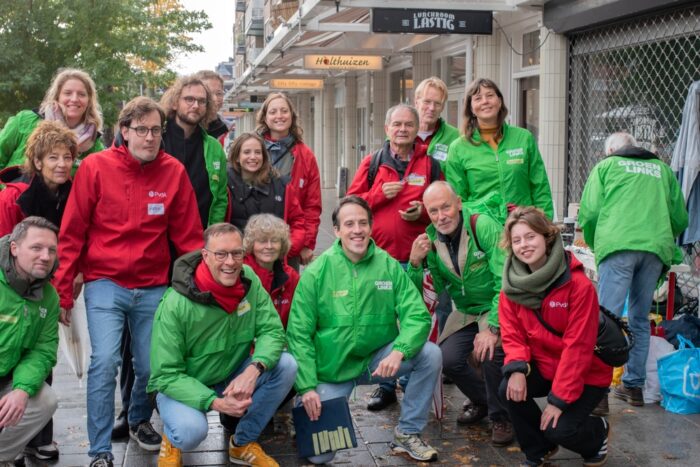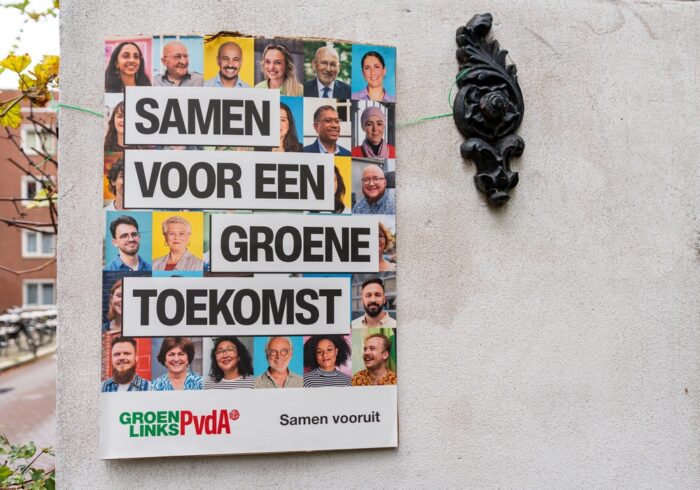The Progressive Post
Last call for the Dutch Left?

Last week’s elections in the Netherlands show a disastrous result for the three traditional left-wing parties. But defining themselves by emphasising their differences, steadily diminishes their common impact. There is a debate on uniting these three parties into one. A major intervention is certainly required, but a merger should not be the only solution.
This time, many left-wing voters switched to the culturally progressive, but economically right-wing D66, as well as to the small, more identity-driven parties on the left side. Along with the enormous rallying around the flag effect that favoured the governing conservative-liberal party (VVD), and the rise of three right-wing parties that are becoming more extremist by the day, it is not an understatement that the progressive Left, that consists of the Labour Party (PvdA), the GreenLeft party (GroenLinks) and the Socialist Party (SP) is in dire straits.
In the couple of days that have passed since the elections, commentators of all shapes and forms, both in and outside the Left movement, have outdone each other to interpret the political landscape that surfaced. Because of the panoptical focus, their interpretations are often contradictory. But in one sense they show consistency: most argue that the existing fissured Left needs to come to an integration of the different parties mentioned above, in order to form one strategic power bloc. That way, it will be possible to raise leverage, or at least to present undivided alternative left-wing policies, against the very dominant socio-economic politics of the Right and the liberals. Very noteworthy is Hans Keman’s observation that the current developments have been a long time coming, a point also expressed by several other political scholars like Cas Mudde. Keman makes the irresistible – although harsh – call for the Left to either modernise or die.
This is by no means a new debate. Several times in the past already, the congress of the Labour Party has adopted motions in this direction. And indeed, cooperation between the different left-wing parties within the parliament, as well as deliberations on joining forces at the level of the party organisation, are also common. In fact, the idea that the parties should merge into one is also resonating strongly at this moment, albeit less within than outside the parties. What is holding us back? Is it a lack of a joint ideology, the parties’ traditions and structures, insurmountable differences between party leadership, rank and file membership, or groups of voters or parts of society whose interests are to be defended? Or perhaps all of the above to some extent? In my opinion, the question of merging or not is rather shallow. Too much attention is addressed to that possible final step. While it is absolutely necessary to analyse the overlaps and the complementariness, the differences between the parties cannot be ignored either.
It can be assumed that the fundamental principles of the three main left-wing parties do not differ to the extent that this would not allow them to integrate. Equality, social justice, emancipation, fairness, redistribution of resources: the roots are the same and determine their identification as Left. Obviously, the weight given to the principles are not always the same, but that is also true within the parties.
The three parties do however each have a distinctive image. The GreenLeft party portrays itself as the progressive champion, internationalist and very EU-supportive, its core issues being climate change and social progress. The Socialist Party sees itself as the guardian of the interests of the less well-off people, with a sharp eye for social injustice and the detrimental impact of immigration and neo-liberal EU policy on the already vulnerable people. The Labour Party is the only one of the three parties that have participated in government. It is largely responsible for building the Dutch welfare state and delivered on issues like good work and social protection, housing and care for large groups in society. Solidarity and connecting different socio-economic groups in society is deeply rooted in the party and still its raison d’être. It seems that these images, and what they stand for, are rather complementary and that no time nor energy should be wasted anymore on hair-splitting on the differences.
Earlier attempts to join forces often stranded when the parties became bigger or smaller in the polls and the outcomes of elections. Logical, because they fish in the same pond of voters. Not seldom, the parties fought each other instead of their common opponents. Today, all three are more or less the same size and face the same problem, so that barrier seems to be gone. However, the trust that is needed for the unifying process requires an explicit commitment and also an understanding of each other’s hesitations. Which needs to be supported by not just the party insiders, but also its constituents in their membership and supporters. In order to gain that support, it could be opportune to be more open and transparent about the process of a potential unification.
The eagerness of the media to address this subject has for years continuously been answered with secretiveness and beating around the bush by the party leaders. The result was an impression of navel-gazing of the parties, rather than a debate on what they stand for.
But most importantly, the parties should start with formulating a joint ideologically-driven political agenda on issues that really touch peoples’ everyday lives. Issues like rights at work, education, health care and insurance, affordable housing, and the welfare state, that can convince voters that their actual needs and interests are the main focus. It is of key importance that the parties strategically and constructively address the differences between their respective constituents and that they include solutions for all the different groups.
In order to guarantee solidarity between the joining parties, all should be able to see in one glance ‘what’s in it for them’. Preferably, they should also identify interests across the different groups, and address them together in a connected integrated manner. Like for instance climate change and employment opportunities in a Green Social Deal or working conditions and child-care facilities in a Better Work agenda, migrant work and care for the elderly is another possible combination. Again and again, polls show broad support for left-wing socio-economic policies. But at the same time, elections are hijacked and dominated by socio-cultural issues. These issues may not be unimportant, but they will definitely not bridge the increasing and deepening gap between societal groups, according to their social-economic and income status.
We do not know if it is the last call for the Dutch Left, but let’s treat it as such!
Photo Credits Shutterstock.com/DutchmenPhotography
Related articles:
Dutch elections 2021: no recovery of Social Democracy!, by Hans Keman.
The Dutch 2021 elections: education as the new divide?, by André Krouwel.




